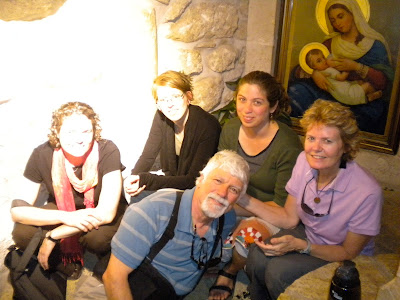 |
| Map showing the territory of Palestinians from 1949 to 1967 to today. |
We crossed into Bethlehem by car, following Dr. P's direction. Since we were clearly quite white and had American passports, all we had to do was wave our passports at the guards on the way in. Dr. P took us to the various interesting sites in Bethlehem that I've already talked about on here. But at lunch in the Bedouin restaurant, he started talking about what life is like for Palestinians. In 2002, the giant concrete wall was erected that now separates the West Bank from Israel. But it was not erected on the lines drawn up by the UN. It was erected far (sometimes very far) inside those lines. It was erected around fertile lands, many of which ended up on the Israeli side. It was erected over top of houses and farms, dividing communities and creating dead ends where there used to be main thoroughfares.
The wall is the most visible and powerful sign of the apartheid that exists here (I use that word deliberately, aware that it will provoke some to anger, because it seems the most true). The Palestinians who are behind it are persecuted in many other ways. Primarily, though, they are trapped like mice in a science experiment.

I stayed for dinner with another missionary who has been living in Bethlehem for a year. As a white American, she can go relatively freely through the gates between Jerusalem and Bethlehem. But her Palestinian friends cannot. They are stuck. Many of the children she knows say they dream of going to Jerusalem one day. Jerusalem, which is FIVE miles away, is a thing of dreams!
She also told a story that still just sticks in my heart. Many Palestinians have work permits that do allow them to travel to Jerusalem for work. To do this, they have to line up at the gate as early as 4am, and wait 2-3 hours in line to cross by foot. The same wait greets them at the end of the day when they come home. One day, this missionary was going from Bethlehem to Jerusalem, and made her way through the three sets of turnstiles and armed guards that create a checkpoint. On the other side, she encountered a long line of Palestinians. Talking to them, she found out that they had been there for hours, waiting. Hoping to be helpful, she spoke to the guard at the gate. The guard said she could not let them through, because there was no other guard on the other side to receive them. The missionary said that was not true, that she had just passed several guards that let her through. The soldier denied this, continuing to claim that there was no one there. The missionary pleaded with her, saying, "Please, let them through. they are just human beings trying to get home to their families." The soldier's reply? "They are NOT human beings. They are terrorists! And they will wait here until we are ready."
Sadly, this seemed to be a common attitude that the missionary encountered. It was not common to all the Israelis I met in Israel, but there was a general unease about Palestinians, a preference not to talk about them.
Granted, the Palestinians are far from innocent as a whole. They have committed their share of violent crimes against the people of Israel, many of whom are civilians. But the fact remains, it seems clear to me, that they are the oppressed and the minority here. They are the ones who are trapped behind the wall, and peace will not be able to flourish until the wall is torn down, or at least made far more permeable. The longer there is entrapment within the borders of a wall, the more pressure will build, until violence erupts on all edges.
That night, I got to experience walking through the checkpoint. It truly felt like a prison, with armed guards watching from tall pillars above us, lots of fences and gates and steel. At one of the turnstiles, no guard was there, so we were stuck, yelling for ten full minutes for help. It was scary. Fears started to flood my mind about whether I would get home that night. Finally, a guard came and passed us through. That was just ten minutes. Imagine doing that for hours because you're not white and American or Israeli.
 |
| Entering the Palestinian side of the checkpoint. |
 |
| On the Israel side of the checkpoint. Note lots of barbed wire and fencing. This was gate one of three. |
On the Palestinian side, the wall contains many beautiful messages of protest. You can see a few here. I offer them as a prayer for productive peace.








































